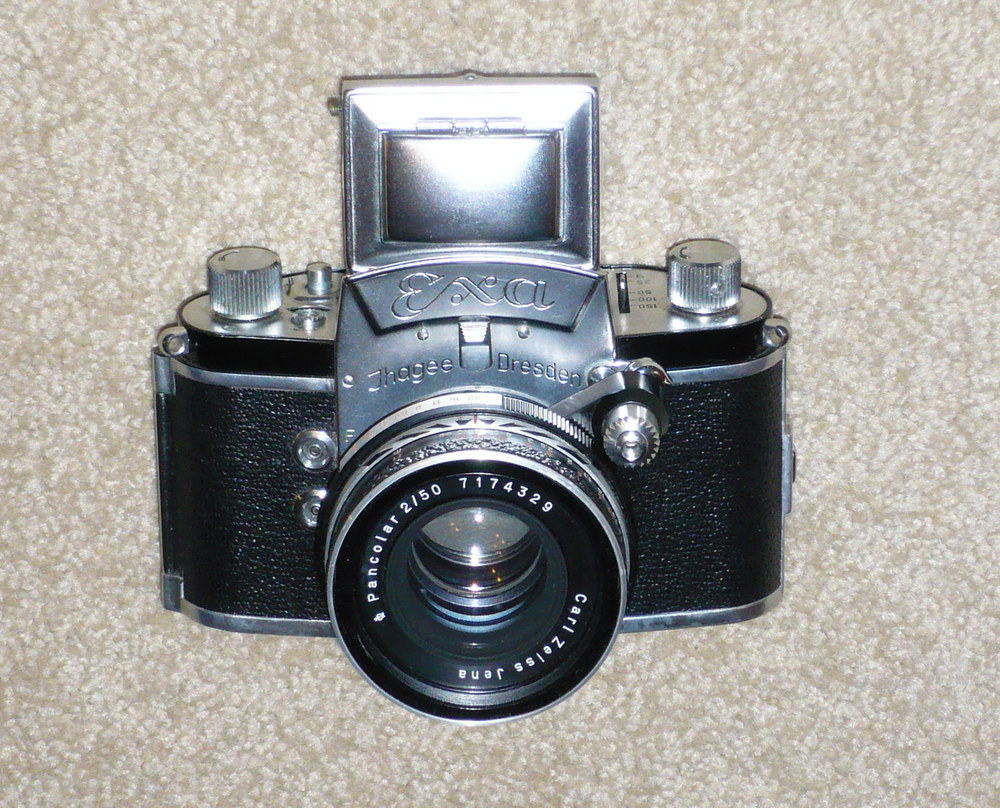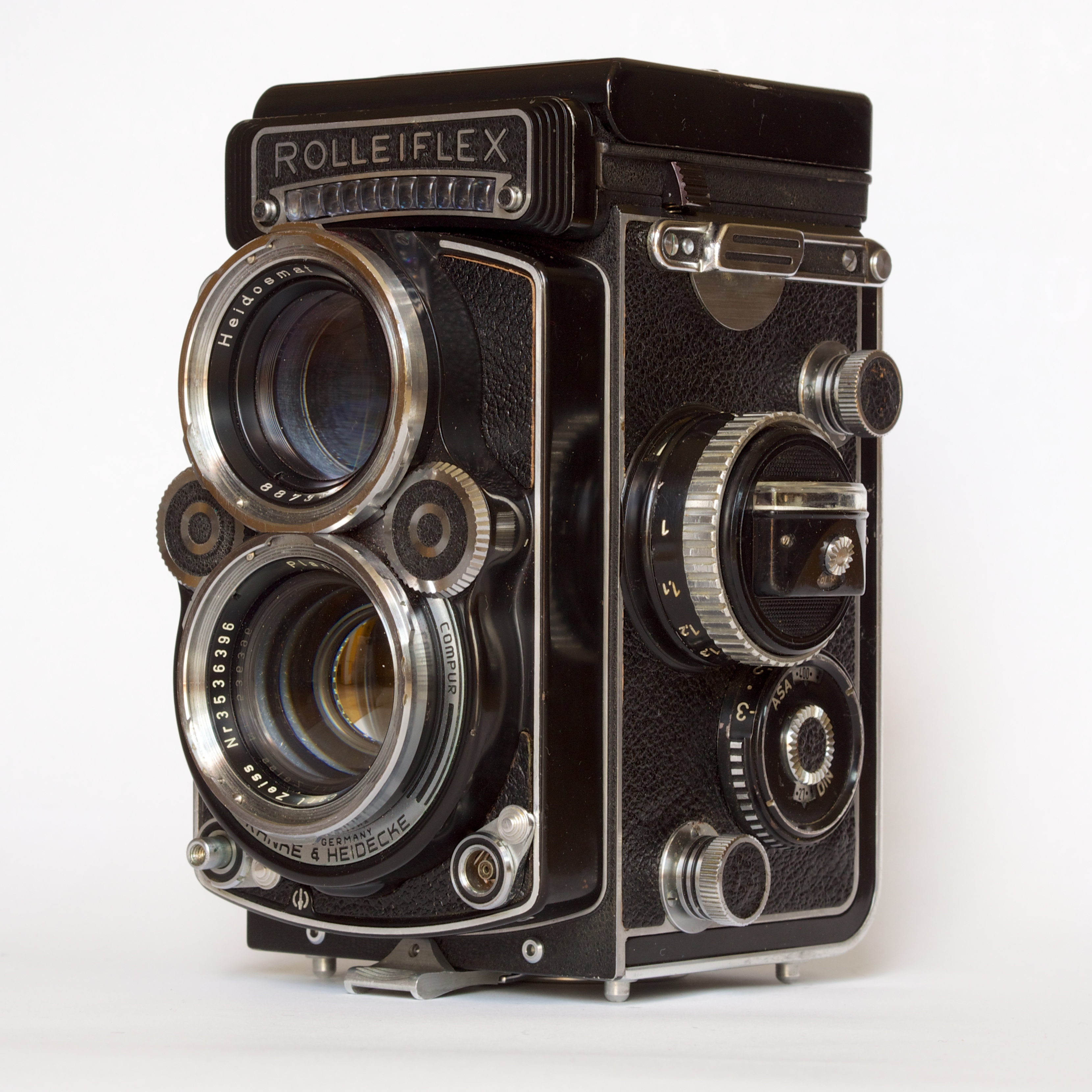|
Rolleiflex SL2000F
The Rolleiflex SL2000F is a line of modular 135 film single lens reflex cameras (SLR) made by Rollei which share the QBM lens mount with the earlier Rolleiflex SL35 line, adding interchangeable film backs, similar in concept to contemporary medium format SLR systems including the Rolleiflex SL66 / SLX, Hasselblad V-System, and Mamiya RB67. The SL2000F was first announced at photokina in 1976, and released in 1981 after a prolonged development period. It was succeeded by the SL3003 (1984), which extended the fastest shutter speed from to sec., and SL3001 (1985), a simplified SL3003 which removed the waist-level finder and reverted to sec. History The prototype SL2000 was first exhibited at photokina '76, featuring both aperture- and shutter-priority autoexposure modes along with a top speed of sec. However, when it was released in February 1981 for Germany and selected other European countries, the shutter-priority mode had been dropped and the top speed reduced ... [...More Info...] [...Related Items...] OR: [Wikipedia] [Google] [Baidu] |
Rollei
Rollei () is a German manufacturer of optical instruments founded in 1920 by and in Braunschweig, Lower Saxony, and maker of the Rolleiflex and Rolleicord series of cameras. Later products included specialty and nostalgic type films for the photo hobbyist market. Originally named ''Werkstatt für Feinmechanik und Optik, Franke & Heidecke'', the company renamed into ''Rollei-Werke Franke & Heidecke GmbH'' in 1972, ''Rollei-Werke Franke & Heidecke GmbH & Co. KG'', in 1979, and ''Rollei Fototechnic GmbH & Co. KG'' in 1981. After being purchased in 1995 by Samsung Techwin, part of the South Korean Samsung Group, it was sold back to its internal management in 1999. In 2002, it was bought by a Danish investment group, and renamed ''Rollei GmbH'' in 2004. In 2005/2006, the company headquarters moved to Berlin and the company was split into two different companies: ''Rollei GmbH'' in Berlin, owner of the Rollei brand and selling various OEM equipment, and ''Rollei Produktion GmbH'' ... [...More Info...] [...Related Items...] OR: [Wikipedia] [Google] [Baidu] |
Single Lens Reflex Camera
In photography, a single-lens reflex camera (SLR) is a type of camera that uses a mirror and prism system to allow photographers to view through the lens and see exactly what will be captured. SLRs became the dominant design for professional and consumer-level cameras throughout the late 20th century, offering interchangeable lenses, through-the-lens (TTL) metering, and precise framing. Originating in the 1930s and popularized in the 1960s and 70s, SLR technology played a crucial role in the evolution of modern photography. Although digital single-lens reflex (DSLR) cameras succeeded film-based models, the rise of mirrorless cameras in the 2010s has led to a decline in SLR use and production. With twin lens reflex and rangefinder cameras, the viewed image could be significantly different from the final image. When the shutter button is pressed on most SLRs, the mirror flips out of the light path and allows light to pass through to the light receptor and the image to be captured. ... [...More Info...] [...Related Items...] OR: [Wikipedia] [Google] [Baidu] |
135 Film
file:135film.jpg, 135 film. The film is wide. Each image is 24×36 mm in the most common "small film" format (sometimes called "double-frame" for its relationship to the "single-frame" 35 mm movie format or full frame after the introduction of 135 sized digital sensors; confusingly, "full frame" was also used to describe the Full frame (cinematography), full gate of the movie format half the size). file:LEI0060 186 Leica I Sn.5193 1927 Originalzustand Front-2 FS-15.jpg, Leica I, 1927, the first successful camera worldwide for 35 cine film 135 film, more popularly referred to as 35 mm film or 35 mm, is a format of photographic film with a film gauge of loaded into a standardized type of magazine (also referred to as a cassette or cartridge) for use in 135 film cameras. The term 135 was introduced by Kodak in 1934 as a designation for 35 mm film specifically for still photography, perforated with Kodak Standard perforations. It quickly grew in populari ... [...More Info...] [...Related Items...] OR: [Wikipedia] [Google] [Baidu] |
Hot Shoe
Canon EOS 350D Hot shoe Proprietary hot shoe used by Minolta and older Sony cameras (Konica Minolta Maxxum 7D)">Sony">Minolta and older Sony cameras (Konica Minolta Maxxum 7D">Sony.html" ;"title="Minolta and older Sony">Minolta and older Sony cameras (Konica Minolta Maxxum 7D) A hot shoe is a mounting point on the top of a camera to attach a flash (photography), flash unit and other compatible accessories. It takes the form of an angled metal bracket surrounding a metal contact point which completes an electrical connection between camera and accessory for standard, brand-independent flash synchronization. The hot shoe is a development of the standardised "accessory shoe" or "cold shoe", with no flash contacts, formerly fitted to cameras to hold accessories such as a rangefinder, or flash connected by a cable. The dimensions of the hot shoe are defined by the International Organization for Standardization (ISO) in ISO 518:2006. Details such as trigger voltage are not standar ... [...More Info...] [...Related Items...] OR: [Wikipedia] [Google] [Baidu] |
Flash Synchronization
In photography, flash synchronization or flash sync is the synchronizing the firing of a photographic flash with the opening of the shutter admitting light to photographic film or electronic image sensor. In cameras with mechanical (clockwork) shutters synchronization is supported by an electrical contact within the shutter mechanism, which closes the circuit at the appropriate moment in the shutter opening process. In electronic digital cameras, the mechanism is usually a programmable electronic timing circuit, which may, in some cameras, take input from a mechanical shutter contact. The flash is connected electrically to the camera either by a cable with a standardized coaxial PC (for Prontor/Compur) connector (as defined in ISO 519), or via contacts in an ''accessory mount'' ( hot shoe) bracket. Faster shutter speeds are often better when there is significant ambient illumination, and flash is used to flash fill subjects that are backlit without motion blur, or to in ... [...More Info...] [...Related Items...] OR: [Wikipedia] [Google] [Baidu] |
Rolleiflex
Rolleiflex is a long-running and diverse line of high-end cameras originally made by the German company Franke & Heidecke, and later Rollei-Werke. History The "Rolleiflex" name is most commonly used to refer to Rollei's premier line of medium format twin lens reflex (TLR) cameras. (A companion line intended for amateur photographers, Rolleicord, existed for several decades.) However, a variety of TLRs and SLRs in medium format, and zone focus, and SLR 35 mm, as well as digital formats have also been produced under the Rolleiflex label. The 120 roll film Rolleiflex series is marketed primarily to professional photographers. Rolleiflex cameras have used film formats 117 (Original Rolleiflex), 120 (Standard, Automat, Letter Models, Rollei-Magic, and T model), and 127 (Baby Rolleiflex). The Rolleiflex TLR film cameras were known for their exceptional build quality, compact size, modest weight, superior optics, durability, simplicity, reliable mechanics and bright viewfi ... [...More Info...] [...Related Items...] OR: [Wikipedia] [Google] [Baidu] |
Single Lens Reflex Camera
In photography, a single-lens reflex camera (SLR) is a type of camera that uses a mirror and prism system to allow photographers to view through the lens and see exactly what will be captured. SLRs became the dominant design for professional and consumer-level cameras throughout the late 20th century, offering interchangeable lenses, through-the-lens (TTL) metering, and precise framing. Originating in the 1930s and popularized in the 1960s and 70s, SLR technology played a crucial role in the evolution of modern photography. Although digital single-lens reflex (DSLR) cameras succeeded film-based models, the rise of mirrorless cameras in the 2010s has led to a decline in SLR use and production. With twin lens reflex and rangefinder cameras, the viewed image could be significantly different from the final image. When the shutter button is pressed on most SLRs, the mirror flips out of the light path and allows light to pass through to the light receptor and the image to be captured. ... [...More Info...] [...Related Items...] OR: [Wikipedia] [Google] [Baidu] |
Rolleiflex SL35
The Rolleiflex SL35 is a range of single-lens reflex, SLR cameras manufactured and sold by the German camera maker Rollei from 1970 to 1982. This range of cameras uses 35mm format, 35mm film. The camera bodies were initially made in Germany. After Zeiss Ikon discontinued camera production, Rollei acquired the Voigtländer brand and camera designs in 1972, and began producing a second generation of SLR cameras in Singapore starting from 1976. Some of those second-generation cameras were rebranded and marketed as Voigtländer VSL. The Rolleiflex SL35 line uses QBM (Quick Bayonet Mount) mount, with a flange focal distance of 44.5 mm. The QBM was re-used by Rollei for the Rolleiflex SL 2000 F (1981) and successor 3003 (1985), which were modular 135 film SLR cameras similar in concept and execution to contemporary Hasselblad V-system and Rolleiflex SL66/6006 cameras. History First generation cameras The Rolleiflex SL35 was a line of 35mm SLR cameras which were develope ... [...More Info...] [...Related Items...] OR: [Wikipedia] [Google] [Baidu] |
Medium Format
Medium format has traditionally referred to a film format in photography and the related cameras and equipment that use film. Nowadays, the term applies to film and digital cameras that record images on media larger than the used in 35 mm photography (though not including 127 sizes), but smaller than (which is considered large format photography). In digital photography, medium format refers either to cameras adapted from medium-format film photography uses or to cameras making use of sensors larger than that of a 35 mm film frame. Some of the benefits of using medium-format digital cameras include higher resolution sensors, better low-light capabilities compared to a traditional 35mm DSLR, and a wider dynamic range. Characteristics Medium-format cameras made since the 1950s are generally less automated than smaller cameras made at the same time. For example, autofocus became available in consumer 35 mm cameras in 1977, but did not reach medium format un ... [...More Info...] [...Related Items...] OR: [Wikipedia] [Google] [Baidu] |
Rolleiflex SL66
The Rolleiflex SL66 is a line of medium format single lens reflex cameras made by Rollei, in regular production starting from 1966 until Rollei's bankruptcy in 1982. The SL66 represented a change in direction for Rollei, which until that time had focused almost exclusively on its popular twin lens reflex cameras, the Rolleiflex and Rolleicord. The Rolleiflex SLX, which was introduced in 1973, effectively replaced the SL66, although the older camera continued in production. After reorganization, Rollei resumed production of the SL66 and introduced the SL66E; variants of the SL66 were introduced and produced until the line was discontinued in 1992. History In 1957, a gentlemen's agreement between Reinhold Heidecke, inventor of the Rolleiflex TLR, and Victor Hasselblad, inventor of the Hasselblad SLR, was reached to ensure that Rollei would not manufacture Single-lens reflex camera, SLR cameras, and Hasselblad would not manufacture Twin-lens reflex camera, TLR cameras. However, the ... [...More Info...] [...Related Items...] OR: [Wikipedia] [Google] [Baidu] |








